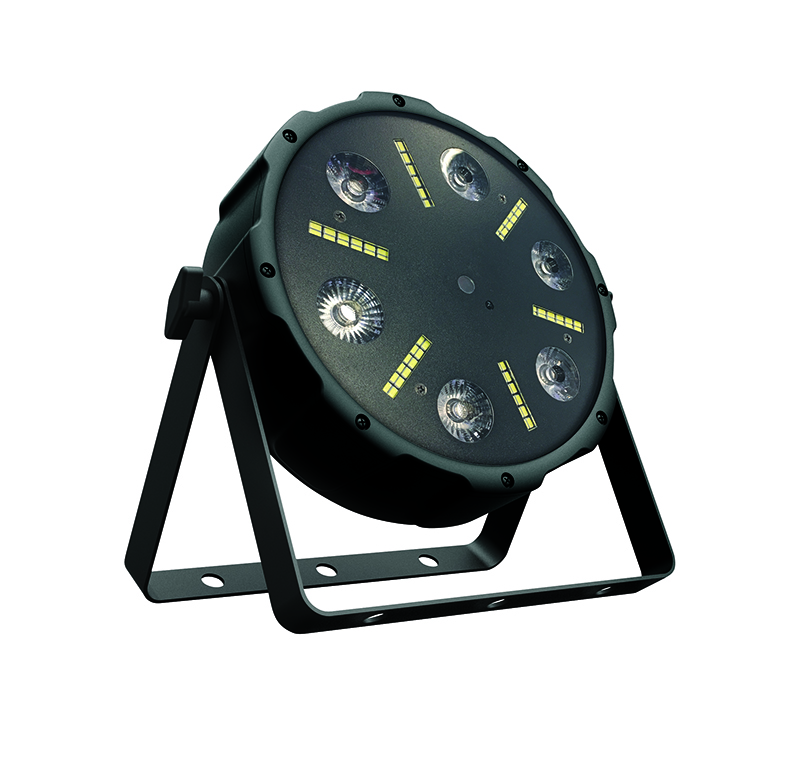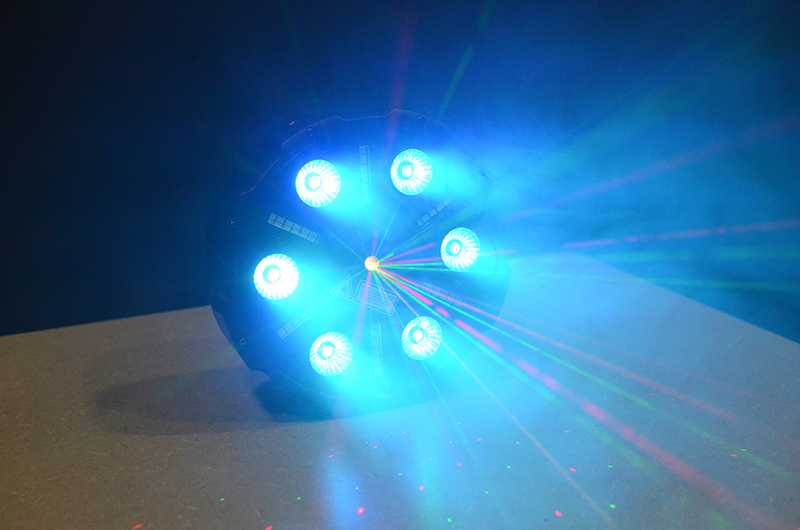
Not every production is a stadium tour, and not every show needs to have lighting to figuratively melt faces and destroy eyeballs. Sometimes, what’s needed is more subtle, less expensive, and easily tossed into your gig bag with a few microphones, a couple of XLR cables, and some power strips. Sometimes, an inexpensive and entry-level product is the one that a production most needs, and the one that will be the most cost-effective in the long-run.
Designed for Club/DJ Use
ADJ has long been a player in the club and DJ scene, coming up with creative lighting solutions to cover mid-market needs at an affordable price point. In January, ADJ group acquired Eliminator Lighting, and the product that we’re looking at, the Trio PAR LED RG, is a combination LED unit with some interesting effects. The Eliminator series is made for today’s mobile DJ; the kid who wants to light his friend’s band, have some tasty beams and pixel effects, but still keep things affordable. These are the sorts of fixtures that will find themselves transported from gig to gig wrapped in packing blankets in the back of a van — they are not designed to ride around the country mounted in a truss.
The unit follows the basic form of most contemporary LED units of this type, with mostly plastic construction on the exterior. (Side note: PAR is a bit of a misnomer, as this unit has reflectors that are neither aluminum nor parabolic, but that moniker for this style of light has stuck.) The circular face is approximately 21.6 cm (8.5 inches) across, and the unit is approximately 6.35 cm (2.5 inches) deep and weighs in at 0.9 kg (2lbs).

RGB LEDs
The fixture has four separate light sources. Most obvious are the six 9W RGB LEDs on the face, for a total of 54W out of the RGB emitters. These are topped with acrylic TIR lenses to combine and focus the output and arranged in a circle around the face of the fixture, with the white LED strobe strips in between — more about those later. Color mixing is as expected from an RGB system — this is a light for effect lighting, not pointing at actors or scenery. Each LED is capable of being individually controlled, and some interesting effects can be produced by pixel-mapping across the face of the fixture. I measured 435 lux at five meters after allowing the fixture to come to thermal equilibrium for twenty minutes, down from an initial value of 460 lux, a thermal drop of ~6%. A side note: the LED drivers in this unit make an audible high-pitched whine while in operation, something to be aware of when operating multiple units in a sound-sensitive environment, though I doubt the noise will be a concern for the usage scenarios that this light is intended for. The only other noise from this unit is the fan, which is thermostatically-controlled, ramping up and down to help cool the LEDs while in operation as needed.
White LED Strobe Strips
In between the RGB LED emitters are the strobe strips. These are six strips of 12 cool white LEDs arranged in two-wide strips, in a wheel spoke pattern, for a total of 72 LEDs. These are used for strobe effects, and each “spoke” of the LEDs can have its intensity individually controlled, but the strobe channel will affect all the strips at once. Strobing is variable-speed synchronous strobes only; other strobe functions will need to be built in your desk. The strips are quite bright, and make an impactful punch that’s great for such a small unit. Strobe strips can also be turned on to use as a wash or blinder effect. Lots of interesting effects can be created by running effects across the strips, especially in various groupings and blocks.

Two Laser Diodes
Next we come to the special effects this light is capable of, the two lasers. Emitted from the very center of the fixture through a small aperture, the Trio PAR LED RG has two lasers in it, a red 635 nm laser and a green 532 nm laser. The lasers are emitted from two separate diodes, placed at 90º angle to each other, combined to the same output aperture with a piece of semi-silvered glass set at a 45º angle between the two diode outputs. As the beams exit, they pass through a piece of diffraction film to diverge the light, and project an intense spray of brightly colored dots around the room. The lasers are not dimmable, they are only on or off. The two laser outputs also do not overlap, so that with both lasers on, the unit projects red and green dots. Finally, a small IR receiver on the front face of the fixture picks up IR commands from an included remote. The user can control the relative levels of red, green, blue, the white strobes, and the two lasers, as well as send a reset command to the fixture. Different modes, including pre-programmed fades, pulses, and the sound activated modes can be selected from the remote control, as well. A menu system on the back allows access to the light’s functions, including manual functions, addressing, and sound functions. The menu is accessed via four buttons and an eight-segment display.
Power and Control
The ADJ Trio Par LED RG accepts power via standard IEC ins and pass-throughs for daisy-chaining power to the fixtures, and auto-ranges from 100-240V. Data input is via 3-pin DMX inputs and pass-throughs or IR remote control. While running under DMX control, fixture personalities between six and thirty channels can be selected, depending on the user’s needs. A mounting bracket is included to attach the rigging hardware of your choice, and the unit includes a standard IEC cable for power.
At a Glance:
Getting the Party Started
The ADJ Trio Par LED RG is a light aimed squarely at people who might otherwise be priced out of owning or renting professional gear, and provides an inexpensive entry into the world of lighting for DJs, party planners, and houses of worship. While this light is not intended to stand up to the rigors of touring, not every LED PAR on the market needs to be. The ADJ Trio PAR keeps the end user’s budget in mind while still providing good functionality at a price point that allows even the entry-level folks a piece of the lighting action. The strobes and lasers provide an interesting addition to the basic LED par, and add an interesting twist that gives this light a visually unique look in any situation.
PROS: Inexpensive, the lasers are an interesting effect. Cool color macros and intensity on board macros, Can control with a remote that comes with it.
CONS: The LED drivers make a slight audible whine when operating. May need a little glue at times.
SPECS
- Light source 1: 6 x 9W RGB 3-in-1 emitters
- Light source 2: 6 slats (12 cool white LEDs each) for strobing
- Light source 3: Red 6.5 nm laser beam
- Light source 4: Green 532 nm laser beam
- Size: 8.5 x 8.5 x 2.5”
- Weight: 2 pounds
- Input Power: 100-240 volts
- Control: DMX via 3 pin XLR or remote (included); effects can be triggered individually sound activation and/or auto programs
- MSRP: $179.95
- Manufacturer: Eliminator Lighting/ADJ
- More Info: www.eliminatorlighting.com


